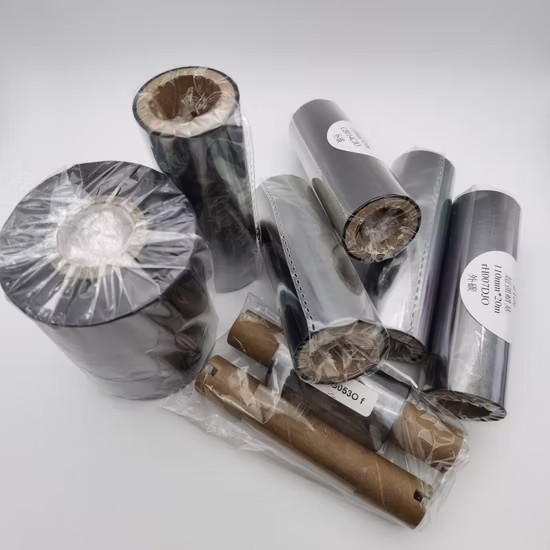Blog
Apa Itu Pita Printer Thermal dan Bagaimana Cara Kerjanya?
Industrial settings demand high labeling precision and durability which makes thermal printer ribbons essential components for operational success. Distributors, resellers and purchasing managers need to comprehend thermal transfer technology and its ribbons to supply reliable high-performance labeling solutions.
Thermal printer ribbons ensure information remains readable under tough conditions for logistics and warehousing professionals as well as electronics and pharmaceuticals businesses. This resource explains the operational principles of thermal printer ribbons while detailing their various types and uses for optimal business selection.
Understanding the Basics: What Is a Thermal Printer Ribbon?
Definition
A thermal printer ribbon consists of a coated film roll that thermal transfer printers utilize to generate long-lasting high-quality printouts. The ribbon contains wax or wax-resin or resin ink which gets melted onto labels via heat application.
How It Works
- A thermal transfer printer heats the ribbon.
- The heat melts the ink so it moves from the ribbon and adheres to the label surface.
- The printing process generates a barcode or image that remains resistant to smudging and maintains durability over time.
Why It Matters in B2B Applications
Thermal transfer ribbons demonstrate exceptional durability when used in environments that expose them to abrasion, moisture or oil exposure, extreme temperatures, and harsh chemicals.
- Abrasion
- Moisture or oil exposure
- Extreme temperatures
- Harsh chemicals
Main Components of a Thermal Printer Ribbon
1. Back Coating
Protects the printhead and improves heat conduction.
2. PET Film (Base Layer)
Provides ribbon stability and uniformity.
3. Ink Layer
The ink layer serves as the printable part which transfers onto the label through melting. Its composition defines the ribbon type.
4. Ribbon Core
The ribbon core maintains the ribbon which comes in various sizes and types such as 1” and 0.5”.
Types of Thermal Printer Ribbons
1. Wax Ribbons
- Ideal for coated/uncoated paper labels
- Cost-effective
- Good for high-speed printing
- Moderate resistance to smudging
2. Wax-Resin Ribbons
- Balanced durability and quality
- Excellent on synthetic materials
- Water and scratch-resistant
- Suitable for shipping, inventory, and healthcare
3. Resin Ribbons
- Highly durable and chemical-resistant
- Works on polyester, polypropylene, vinyl
- Ideal for laboratory, electronics, and industrial applications
Thermal Transfer vs. Direct Thermal Printing
| Feature | Thermal Transfer | Direct Thermal |
|---|---|---|
| Durability | High | Low |
| Requires Ribbon | Yes | No |
| Suitable for Harsh Conditions | Yes | No |
| Print Longevity | Long-term | Short-term |
| Cost | Higher upfront | Lower upfront |
Industry Applications of Thermal Printer Ribbons
1. Logistics and Warehousing
- Pallet labels
- Inventory tracking
- Shipping labels
2. Pharmaceuticals and Healthcare
- Lab sample tracking
- Patient identification
- Medical device labeling
3. Manufacturing and Electronics
- Product serial numbers
- Compliance labeling
- Circuit board identification
4. Automotive and Aerospace
- Part tracking
- Maintenance tags
- Safety labels
5. Food and Beverage
- Nutritional labeling
- Barcode traceability
- Refrigerated packaging
To select an appropriate thermal printer ribbon you need to evaluate label material compatibility.
Step 1: Identify Your Label Material
Match ribbon type to surface:
- Paper → Wax or wax-resin
- Synthetic → Wax-resin or resin
Step 2: Define Environmental Conditions
- Humidity → Go with wax-resin or resin
- Chemical exposure → Choose full resin
- Indoor use only → Wax is sufficient
Step 3: Confirm Printer Compatibility
Check:
- Printer model
- Core size (e.g., 1″ or 0.5″)
- Ink side (inside or outside)
Step 4: Select Width and Length
Common widths: 55mm, 110mm, 220mm
Common lengths: 74m, 300m, 450m, 600m+

Customization Options for Bulk Orders
Core Size and Material
- Plastic or cardboard
- 1″ or 0.5″ inner diameters
Winding Direction
- Choose ink side orientation based on specific printer model requirements
Label/Ribbon Matching
- Pre-printed or color-coded coordination
Packaging
- Shrink-wrapped
- Carton boxed
- Custom labeling with SKU/barcodes
Thermal printer ribbons provide multiple benefits when employed in industrial environments.
1. Long Print Lifespan
Suitable for products that need extended shelf life and international shipping requirements.
2. High Print Quality
These thermal printer ribbons provide excellent quality for printing small font sizes along with high-density barcodes and labels with detailed data.
3. Low Maintenance
Thermal transfer printers that use ribbons experience extended service life while requiring less maintenance.
4. Versatility
The product functions with thousands of printer models and different substrates.
Bulk Purchasing and MOQ Considerations
MOQ Guidelines
Typical minimum: 500–1000 rolls per spec depending on customization
Lead Times
- Production: 7–15 working days
- Shipping: Air (faster), sea (economical)
Documentation Support
- HS codes
- CO & MSDS documents for export
Storage and Handling Tips
Ideal Conditions
- Temperature: 5°C–35°C
- Humidity: 45–85% RH
- Store away from direct sunlight and dust
FIFO Principle
Prioritize older ribbon stock to prevent product degradation
Printer Care
Maintaining printhead cleanliness after each ribbon use ensures better performance and print quality.
Eco-Conscious Options in Thermal Printer Ribbons
1. Solvent-Free Formulations
Lower VOCs for safer handling
2. Recyclable Cores and Packaging
Use of biodegradable paper cores and cartons
3. RoHS & REACH Compliance
These products have certifications that meet the stringent requirements of international export markets.
Conclusion
High-demand industrial applications require thermal printer ribbons because they deliver the necessary label durability and precision. The proper ribbon choice enables your labeling system to consistently deliver dependable performance from basic logistics applications to high-resistance settings.
To achieve maximum operational efficiency and client satisfaction distributors and purchasing professionals need knowledge of appropriate product combinations along with effective storage techniques and customization capabilities. Choosing quality thermal printer ribbons means acquiring more than products—it delivers additional value to operations.
👉 Contact Us
📧 sales@foyottr.com
📞 +86-592-6018318
🌐 https://foyottr.com/
FAQ
The shelf life of a thermal printer ribbon generally lasts between 12 to 24 months if stored correctly.
Typically 12–24 months under proper storage conditions.
Thermal printer ribbons are not universally compatible with all printers and require a verification process based on printer model specifications including ribbon width, ink side, and core size.
No. Ensuring compatibility requires checking printer models and specifications including ribbon width, ink side, and core size.
Since most thermal printer ribbons produce monochrome output by default specialized colored options and specialty inks exist for color printing.
The majority of thermal printer ribbons are black but manufacturers offer custom colors with specialty inks.
Thermal transfer ribbons designed for food labeling are safe since food-grade options exist.
Food-grade thermal printer ribbons that meet indirect food contact standards exist.
To prevent print fading and ribbon breakage you should use the appropriate ribbon type for your specific environment and maintain regular printhead cleaning.
Always select an appropriate ribbon type for your specific environment and maintain the printhead through regular cleaning.

